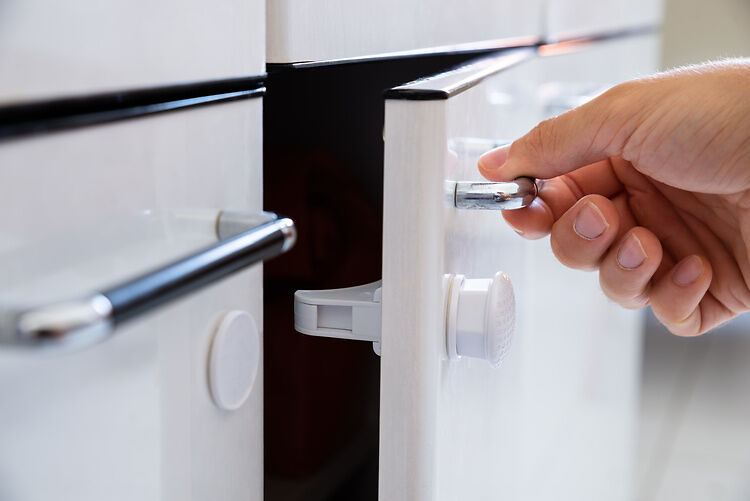Babies’ movements are quite limited – most children take around eight months to begin crawling. So, really, you will be infant-proofing your home. Proofing can be postponed for the first few months of life until your little one can explore and move around on their own. Consider whether you’d rather put in this effort during pregnancy or while caring for a newborn. If you start thinking about it early in pregnancy, you can slowly chip away at the task.
Out of reach, out of mind
Look at your home through a baby’s eyes – or rather, at a baby’s level. What can they reach when crawling around or when they start pulling themselves up?
Go through room-by-room and ensure the ground up to infant-standing height is a safe place. Crawl on your hands and knees if it helps!
Bathroom
- Keep chemicals, scissors, razors, corded electronics, anything small and swallowable or in a plastic wrapping out of reach. Think about lowdown shelves or drawers that wandering hands can open.
- Toilet lid locks can prevent playing in, drinking or falling into the bowl water.
- Toilet paper is not a toy – try placing a rubber band over the roll, which you can easily slide off for use, but your little one’s less than dexterous fingers will struggle to do so.
- Try not to leave items on the shower floor or edge of the bath.
- Lock away any medications, or keep them very high up.
Kitchen
- Low drawers and shelves should only contain non-breakable, non-dangerous items. No knives, forks, heavy pans, glass, china, or small items that could be a choking hazard.
- Never leave cords dangling off counters. Keep kettles and heavy appliances well away from the edge of counters.
- Invest in child-proof latches for drawers if necessary, under the sink or wherever you keep chemicals or dangerous items, and perhaps the pantry as some food and packaging can be choking hazards.
- You can make a cheap fridge latch by placing a sticky hook on the side of the door, and one on the side of the fridge, and latching them closed with a rubber band.
- When pans are on the stove, turn their handles away from the edge.
Household
- Once pulling up and climbing starts, remember that chairs and tables are no longer out of reach. Perhaps forego the glass vase on the kitchen table or leaving plants on accessible surfaces.
- Cover electrical sockets.
- Vacuum regularly to remove small choking hazards from the ground.
- Ensure windows are not easy to open. If so, invest in some window latches.
- Choose furniture with a sturdy base and soft corners. A crawling or climbing baby could knock heavy items off a wobbly table. You might need protectors for any sharp edges on your furniture.
Each household is different, and each child has different interests as to what items seem like fun. The suggestions in this article are not an exhaustive list and there may be other items, risks, and areas to consider so think thoroughly about the specifics of your home. Talk to other parents about tricks and tips for baby-proofing. Think outside the box and imagine what your little one can reach, bump, swallow or get stuck in. Always supervise your infant and help them understand what is and is not safe.
Recommended Articles:
https://www.babybunting.com.au/baby-talk-blog/choosing-proper-footwear-as-your-child-grows/
https://www.babybunting.com.au/baby-talk-blog/Signs-That-Your-Child-Is-Ready-for-Toilet-Training/



